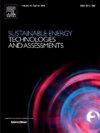Defect detection in photovoltaic modules based on image-to-image generation and deep learning
IF 7.1
2区 工程技术
Q1 ENERGY & FUELS
Sustainable Energy Technologies and Assessments
Pub Date : 2025-07-18
DOI:10.1016/j.seta.2025.104441
引用次数: 0
Abstract
The autonomous monitoring of photovoltaic modules is emerging as an integral approach to maximize performance and reliability of photovoltaic systems, primarily in large-scale applications. However, it suffers with data acquisition, volume, diversity and performance constraints. This study proposed a method to detect multi-defects at module level in electroluminescence images of photovoltaic panels using limited data with synergistic integration of image-to-image generation and transfer deep learning from specific data and knowledge. Therein, StyleGAN3-t based image-to-image generation is firstly used to augment training data. Subsequently, the real-synthetic mix data is used to train YOLOv9 GELAN-e network using develop-model transfer learning from a pre-trained custom cell level model. To validate the effectiveness of proposed method, multiple iterations of image-to-image and object detection networks are studied using real and real-synthetic mix data with different formations, mixed training, and pre-trained general and specific weights. This method achieves FID score of 15.01 for images generation and 7% higher [email protected] for detection of seven classes compared to real data model trained without transfer learning, indicating the synergy and effectiveness of integrating image-to-image generation and transfer learning from specific data. The non-deterministic training for multiple runs also demonstrates the accuracy, stability and reliability of the method. This study contributed a module-level dataset and not only deals with enhanced detection of multi-defects at module and outdoor level but also addresses limited and diverse data constraints, leading to enhanced performance, operation and management of photovoltaic systems.
基于图像对图像生成和深度学习的光伏组件缺陷检测
光伏组件的自主监测正在成为光伏系统性能和可靠性最大化的一个整体方法,主要是在大规模应用中。然而,它受到数据采集、容量、多样性和性能限制的影响。本研究提出了一种利用有限数据对光伏板电致发光图像进行模块级多缺陷检测的方法,将图像到图像生成协同集成,并从特定数据和知识中迁移深度学习。其中,首先使用基于StyleGAN3-t的图像到图像生成来增强训练数据。随后,利用预训练的自定义单元级模型的开发模型迁移学习,利用真实合成混合数据对YOLOv9 GELAN-e网络进行训练。为了验证所提方法的有效性,研究了图像到图像和目标检测网络的多次迭代,使用不同形状的真实和真实合成混合数据、混合训练以及预训练的一般和特定权重。该方法在图像生成方面的FID得分为15.01,在7个类别的检测方面,与未经迁移学习训练的真实数据模型相比,该方法的FID得分提高了7% [email protected],这表明将图像到图像的生成与特定数据的迁移学习相结合的协同性和有效性。多次运行的不确定性训练也验证了该方法的准确性、稳定性和可靠性。本研究提供了一个模块级数据集,不仅在模块和室外级别增强了对多缺陷的检测,而且还解决了有限和多样化的数据约束,从而提高了光伏系统的性能、运行和管理。
本文章由计算机程序翻译,如有差异,请以英文原文为准。
求助全文
约1分钟内获得全文
求助全文
来源期刊

Sustainable Energy Technologies and Assessments
Energy-Renewable Energy, Sustainability and the Environment
CiteScore
12.70
自引率
12.50%
发文量
1091
期刊介绍:
Encouraging a transition to a sustainable energy future is imperative for our world. Technologies that enable this shift in various sectors like transportation, heating, and power systems are of utmost importance. Sustainable Energy Technologies and Assessments welcomes papers focusing on a range of aspects and levels of technological advancements in energy generation and utilization. The aim is to reduce the negative environmental impact associated with energy production and consumption, spanning from laboratory experiments to real-world applications in the commercial sector.
 求助内容:
求助内容: 应助结果提醒方式:
应助结果提醒方式:


